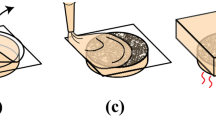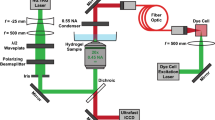Abstract
The existence of cavitation in soft matter introduces challenging problems as it exhibits unique deformation and failure mechanisms. The motivation of our study was to develop an understanding of cavitation and resulting bubble dynamics in and near soft materials, with applications in the study of biological tissues, polymeric coatings, biofouling, composites and other synthetic materials. In this work, we describe a new experimental technique to measure the internal pressure of quasi-statically induced bubbles within compressible time-dependent hydrogels. A Michelson interferometric technique and background-oriented schlieren (BOS) were paired with digital image correlation (DIC) to resolve spatiotemporal pressure fields during cavitation in the bubble and surrounding material. These measurements are meant to inform existing cavitation models and gain new insight into the highly localized deformation mechanism of cavitating bubbles.
Access provided by Autonomous University of Puebla. Download conference paper PDF
Similar content being viewed by others
Keywords
24.1 Motivation
Traditional hydrodynamic applications, such as marine propulsion systems and underwater explosions, have long dominated cavitation research. Investigations have generally focused on cavitation in water and on cavitation-derived damage produced to neighboring submerged hard metallic surfaces. Recently, the recognition and use of cavitation in biological and other soft material systems has motivated the development of understanding bubble dynamics in and near soft materials. We therefore describe a new experimental technique to measure and validate the evolution of the internal pressure of an initially quasi-static bubble within a compressible, time-dependent hydrogel. Once validated, we intend to apply this experimental approach to measure temporal pressure field evolution in dynamic (inertial) cavitation events, e.g., during the inertial laser-induced microcavitation, described by Estrada et al. [1]
24.2 Experimental Approach
Cavitation is the process in which a void emerges in a liquid or solid medium due to localized pressure changes [2]. This study uses needle-induced cavitation (NIC) to validate the methodology quasi-statically [3]. NIC allows cavitation to occur slowly enough for the system to remain in internal equilibrium, facilitating the validation of internal pressure via a conventional transducer. Internal bubble pressure of quasi-static bubble measurements through needle induced cavitation is directly measured using (1) Michelson interferometry and (2) Background-oriented schlieren (BOS).
The NIC rheology technique initiates cavitation in a fluid-filled medium to determine the local mechanical properties of soft materials by measuring pressure and radius evolution of the bubble. Air or immiscible liquid is injected through a needle via a syringe pump until it reaches a critical pressure, which either induces cavitation or fracture depending on material composition and stiffness [3]. This method, pioneered by Crosby et al. [3]., was adapted as a technique to induce cavitation quasi-statically at the center of a hydrogel matrix. The injection needle, tubing, and syringe pump are connected in parallel to a pressure transducer (PX309-300GV, Omega Engineering, Stamford, CT) and controlled by LABVIEW (National Instruments, Austin, TX). As immiscible fluid is quasi-statically injected into the hydrogel matrix, cavitation occurs at the needle tip and pressure inside the bubble is directly measured. Michelson interferometry and BOS simultaneously implemented as independent non-contact methods for obtaining the bubble pressure field.
Figure 24.1 depicts the Michelson interferometer setup, which consists of a 633 nm Helium-Neon (HeNe) laser split into a reference and an object beam, each of which is directed towards mirrors equidistant to the splitting point. The reflected light propagating from both mirrors proceed to recombine at the beam splitter and the resulting interference pattern is redirected onto the detector. A representative experimental interference is provided in Fig. 24.2. The governing principles of interferometry are mathematically represented by Maxwell’s equations of propagation and can be related to changes of refractive index of the propagation medium [4] by,
where I 1 and I 2 are the intensities of the first and second beam respectively and \( \widehat{m} \) and \( \widehat{l\ } \) are unit vectors in a direction of oscillation for each beam. The argument, Φ, denotes the difference between the geometric path length of each beam, which is the measured quantity. It is a function of the difference in propagation vectors of the beams,\( \left(\overrightarrow{k_1}-\overrightarrow{k_2}\right) \), wavelength of light, λ, position vector, \( \overrightarrow{r} \), and relative phase difference of the beams, (φ 1 − φ 2). The phase shift between the beams can be related to refractive index and pressure as:
where d is the distance light travels through the medium with refractive index, n. A and B are constants determined by initial conditions of the experimental system. Assuming a linear relationship between refractive index and pressure, internal pressure measurements of the bubble can be calibrated and measured. This linear relationship is subject to investigation and will be rigorously examined whether it holds true for all conditions of cavitation.
Simulation results of a Michelson interferometer experiment to validate refractive index values (a) Generated interference patterns of a system undergoing incremental changes in refractive index at t1 and t2, with selected region of interest shown (b) Intensity versus spatial radial distance in pixels (c) Intensities over a region of interest as a function of time, where the refractive index linearly increases with time, and peaks indicating a change in path length of λ are marked (d) Refractive indices inputted and outputted from simulation are equal to each other
BOS relates intensity of light with the dispersion density of a fluid, as measured between a light source and a reference background. BOS uses a correlation-based motion tracking technique on a background speckle pattern to quantitatively characterize compressible and thermal flows with high spatial and temporal resolution. As cavitation at the needle tip evolves, the BOS setup will be used to resolve pressure through the Poisson’s equation and the Tait equations (initially), as described by Hayasaka et al. [5]. The BOS motion field is measured using our open source digital image correlation (DIC) algorithm, qDIC (https://github.com/FranckLab/qDIC).
24.3 Validation and Results
NIC is a well-established technique which extends to cavitation pressure measurements reliably. Results from Hutchens et al. show that pressure is linearly dependent with time for a constant flow rate until the bubble reaches a critical pressure where upon a dramatic expansion and collapse of the bubble occurs (cavitation). The authors provide approximate values of maximum bubble radii of 1 mm at critical pressures of 111 kPa for a PMMA-PnBA-PMMA triblock co-polymer [3].
As a preliminary step, simulations in MATLAB (The MathWorks, Natick, MA) demonstrate the use of Maxwell’s governing equations of propagating waves and their application in measuring refractive index and pressure of a sample in the object beam pathway. In the experimental context, changes of refractive index result from the increase in pressure within the bubble from immiscible fluid flow into the system. The simulation generates a fringe pattern for each time stamp and corresponding value of refractive index. Figure 24.2a shows two synthetic interference patterns at t1 and t2 corresponding to different refractive indices inputted into the simulation. The intensity at each pixel in the radial direction for each image is then plotted, an example of which is in Fig. 24.2b. The mean intensity of a small region of interest from each pattern is calculated and plotted with respect to time in Fig. 24.2c. The number of peaks correspond to fringes that have passed through the region of interest, where each fringe corresponds to a change in optical path length, λ. Once the change in optical path length is known, refractive index and pressure can be calculated using Eqs. (24.3 and 24.4). Figure 24.2d shows that the simulation input values of refractive index are equal to the refractive index output values after the analysis is run, thus validating the simulation.
24.4 Conclusion
This study aims to build an interferometric experimental technique to directly measure the internal bubble pressure of quasi-statically evolving cavitation events. The Michelson interferometer is validated through direct measurement of pressure and BOS. Using quasi-static bubble evolution to validate this methodology will render this method versatile in several other investigations involving solid-fluid interactions, particularly for resolving temporal pressure fields of laser-induced inertial microcavitation.
References
Estrada, J., Barajas, C., Henann, D., Johnsen, E., Franck, C.: High strain-rate soft material characterization via inertial cavitation. J. Mech. Phys. Solids. 112, 291–317 (2018)
Brennen, C.E.: Cavitation Bubble Dynamics. Cambridge University Press (2013)
Hutchens, S., Fakhouri, S., Crosby, A.: Elastic cavitation and fracture via injection. Soft Matter. 12, 2557–2566 (2016)
Kachiraju, S., Gregory, D.: Determining the refractive index of liquids using a modified Michelson interferometer. Opt. Laser Technol. 44(8), 2361–3265 (2012)
Hayasaka, K., Tagawa, Y., Liu, T., Kameda, M.: Optical-flow based background-oriented Schlieren technique for measuring a laser-induced underwater shock wave. Exp. Fluids. 57, 179 (2016)
Author information
Authors and Affiliations
Corresponding author
Editor information
Editors and Affiliations
Rights and permissions
Copyright information
© 2019 The Society for Experimental Mechanics, Inc.
About this paper
Cite this paper
Buyukozturk, S., Landauer, A.K., Franck, C. (2019). Development of an Interferometer and Schlieren Based Measurement Technique for Resolving Cavitation Pressure Fields. In: Kimberley, J., Lamberson, L., Mates, S. (eds) Dynamic Behavior of Materials, Volume 1. Conference Proceedings of the Society for Experimental Mechanics Series. Springer, Cham. https://doi.org/10.1007/978-3-319-95089-1_24
Download citation
DOI: https://doi.org/10.1007/978-3-319-95089-1_24
Published:
Publisher Name: Springer, Cham
Print ISBN: 978-3-319-95088-4
Online ISBN: 978-3-319-95089-1
eBook Packages: EngineeringEngineering (R0)






